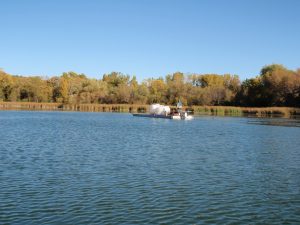Eden Prairie
ABOUT
In 2008, the District completed an alum treatment of Bryant Lake to reduce the amount of phosphorous in the water. The District also completed a wetland restoration upstream to reduce the amount of phosphorous entering the lake.
Project Details
Bryant Lake suffered from an excess of phosphorus, contributing to algae growth. Alum, or aluminum sulfate, is a nontoxic material, commonly used to reduce phosphorus in lakes. Alum forms a fluffy material, called floc, when it comes in contact with water. This material binds with phosphorus and settles to the bottom of the lake. Once the floc settles to the bottom of the lake, it forms a barrier to stop the release of additional phosphorus from the sediment. This leads to less algae and clearer water.
This project included installing a new water level control structure in the Cardinal Creek Wetland area. At the same time, the District also constructed a nature trail around the wetland.
This project was part of the larger Eden Prairie Lakes Water Quality Improvement Project.
Eden Prairie Lakes Water Quality Improvement Project Engineer’s Report (PDF)
Water Quality Impact
As a result of this project, water clarity increased and phosphorous levels and algae have decreased. However, three aquatic invasive species are present in the lake and have become problematic.
